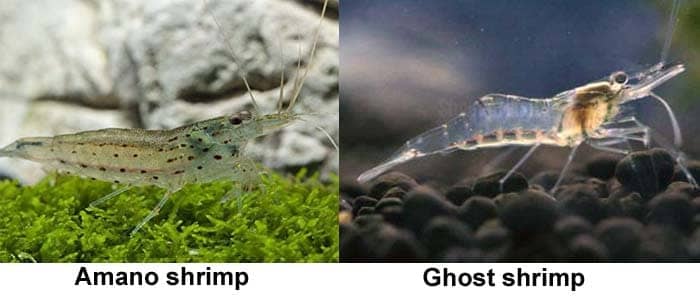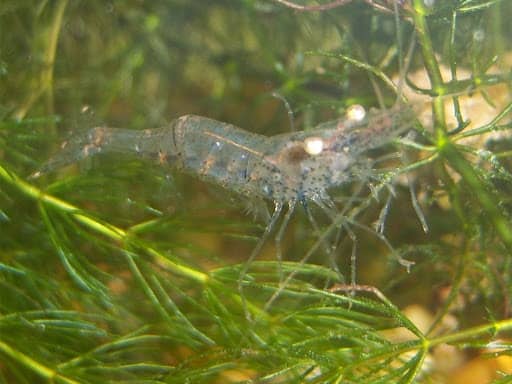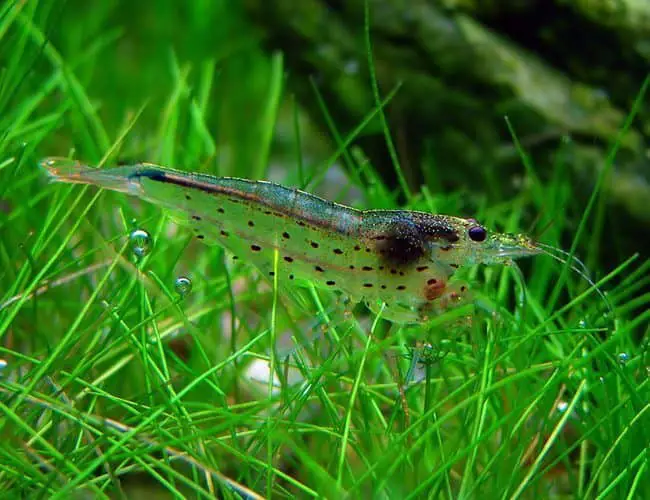Deciding which aquarium shrimp to buy can be confusing because they all look alike (Amano shrimp vs. Ghost shrimp). Buying the correct species of shrimp for your aquarium is crucial because there are many factors to look for. So we are going to help you to decide which shrimp to buy based on my experience.
Ghost shrimp is a crustacean species that native to the fresh waters of North America. They have a transparent body and color dots on their back. Ghost shrimp are also known as Glass shrimp because of their translucent body.

Amano shrimp belongs to the crustacean phylum and is native to Japan. They are famous as an Algae eating shrimp, Caridina japonica, Japonica shrimp, and Yamato shrimp. Amano shrimp has transparent greyish color body markings. The brownish blue or grey dots appear on their body.
The colors of the dots vary with their dietary behaviors. Amano shrimp can grow up to two inches in body size. Now let digging draper into this topic.
How to identify differences between Amano shrimp vs. Ghost Shrimps
Jump To
- 1 How to identify differences between Amano shrimp vs. Ghost Shrimps
- 2 Similarities between the Amano and Ghost Shrimp
- 3 Amano Shrimp vs. Ghost Shrimps Tank and Water Requirements
- 4 Amano shrimp Vs. Ghost shrimp size?
- 5 Feeding Amano vs. Ghost?
- 6 Breeding Amano S vs. Ghost S?
- 7 What fish can live with the Ghost shrimp?
- 8 What fish can live with the Amano shrimp (tank mates)?
- 9 Tips on keeping Amano Shrimp
- 10 Tips on keeping Ghost Shrimp
- 11 Related questions
Ghost shrimp has a clear transparent body, and Amano shrimp has a grayish color transparent body. When comparing the size of the body, Ghost shrimps are slightly smaller than Amano shrimps. Amano shrimp can grow around two inches, and Ghost shrimps can grow around one and a half inches.
Ghost shrimp have longer claws than Amano shrimp. Further, the Ghost shrimp claw is sharper than the Amano shrimp claw. Ghost shrimp have long arms with a claw that can grab prey while Amano shrimp have short fat claw arms mainly for algae ripping.
Both species have omnivorous dietary behaviors. But Amano predominantly feeds on algae, and they feed on blood worms and other small aquatic animals. Other than the above differences, Ghost shrimp breed faster than Amano shrimp. Thus it is easy to breed them. But Amano shrimp requires special water conditions to breed. Therefore, the Breeding of Amano is a bit difficult.
| Ghost shrimp | Amano shrimp |
|---|---|
| Clear transparent body | Grayish color transparent body |
| Clear Body | Dots on body |
| Slightly smaller (0.5 inches) | Slightly large (2 inches) |
| Long arms with a claw | Short fat claw |
| sharper claw | Not sharp |
| Breed faster and easy | Difficult to breed |


Similarities between the Amano and Ghost Shrimp
Similar in size
Both species have small body sizes. It is between 1.5 inches to 2 inches. In both species, the male shrimps are slightly smaller than the female shrimp.
Similar diet
Both Amano shrimp and Ghost shrimp are omnivorous, and their dietary patterns are similar. They feed on algae, plant matter, and animal matter.
Similar behavior
Amino shrimp vs G shrimp have quite peaceful behaviors, and they try to hide in the tank’s plants. Thus, planted fish tanks are ideal for these species. They come out from the plants’ habitat when they feel safe.
Breeding behavior
Adult shrimps of both species showed the same behavior when breeding time started. They are very active in the breeding period, and adult males and females chase each other.
Amano Shrimp vs. Ghost Shrimps Tank and Water Requirements
Ghost Shrimp (Palaemonetes paludosus)

Space requirement:
Ghost shrimp can survive in a 10-gallon fish tank with one tank mate. They are hard crustaceans that can survive in changing water conditions.
Water quality requirement:
Ghost shrimps commonly live at the bottom of the tank, with low currents. They prefer light water flow.
Therefore, you can use an air pump or filter to maintain light water flow. Ghost shrimp get stressed by the high level of nitrate, nitrite, and ammonia compounds.
The nitrate, nitrite, and ammonia levels of the fish tanks should be maintained at a low level. Thus, you should use a suitable filter to overcome these issues.
Substrate requirement:
They explore sandy bottom substrate for foods because they are bottom feeders. The antenna on the Ghost shrimp’s face may get damaged when they rub the hard surfaces. Hence, you should add a fine-grain substrate to the tank bottom.
Tank Habitat:
They prefer fish tanks that have lots of hiding places. In an aquarium, they inhabit rocks, logs, and plants to hide from predators. . The ideal temperature is 33 °C to 50 °C to grow healthy shrimp in your aquarium.
Read How often do ghost shrimp shed/molt? 10 things must know
Related: Cherry Shrimp Babies Care | List of Things You Should Consider |
The pH level of water:
They prefer water that has a pH level of around 7 – 8.
Amano Shrimp

Space requirement:
Amano shrimp requires a 20-gallon fish tank to grow.
Water quality requirement:
Amano shrimp need good water conditions. Thus, nitrite, nitrate, and ammonia levels should be at 0 ppm.
Water Temperature:
The temperature range of water should be between 22 °C to 26 °C for optimum growth. Their metabolism rate is increasing at higher temperature levels.
The pH level of water:
They can live in waters with a pH range between 8 – 8.5, and their life span is around two-three years. The water’s hardness should be around 6-8dkh, and the TDS level should be around 200 ppm. (TDS= Total Dissolved Solids)
Water quality is an important factor for both Amano and Ghost shrimp. Changing water regularly is important to maintain water quality at the optimum level. Thus, change 30% of tank water twice a week to maintain water quality.
Amano shrimp Vs. Ghost shrimp size?
In the wild, female Ghost shrimp grow up around 1.5 inches, and males grow around 1 inch in size. Female Amano shrimp grew up 2 inches in size and male shrimps are slightly shorter than female shrimp. Water condition, fish tank space, feed supply, and diseases directly influence shrimps’ size in aquariums. Therefore, the shrimp size that grows in an aquarium is a little shorter than the shrimp that live in the wild.
Feeding Amano vs. Ghost?
Both Amano shrimp and Ghost shrimp (glass shrimp) are omnivorous, and they eat plant matters and meat matters, including algae, blood worms, brine shrimp, aquatic plants, pellets, flakes fish food. Amano shrimp are popular for feeding on algae. But other than algae, they eat frozen foods, pellets, cucumber, and squash-like foods.
Breeding Amano S vs. Ghost S?
The breeding method of Ghost shrimp is different and relatively more comfortable than Amano shrimps. They do not have specific requirements to breed, and they can naturally breed in an aquarium. But Amano shrimp requires some specific conditions to breed.
Ghost shrimp breeding
Step 1: Take 2 adult male grass shrimp and female shrimp with an even ratio (Male 1: Female 1)
Step 2: Find a suitable environment for parent shrimp. (Planted tank is ideal)
Step 3: Provide favorable water conditions to stimulate breeding.
If the water conditions are favorable, female eggs get fertilized by male sperm. After 4-5 weeks, females release the live fry to the aquarium. Single species tanks protect fry from predatory activities.
Step 4: Collect fry using pipet or turkey baster and add them into a separate freshwater fish tank
(Do not add Ghost babies to your aquarium tank until they grow. You should keep the baby shrimps in a separate aquarium for a few months. Otherwise, other fish species may eat newborn babies easily)
Step 5: Provide suitable feed to baby shrimp (Algae or Plankton)
Amano shrimp breeding step by step
In a natural environment, male and female shrimps mate in freshwater, and females lay eggs on brackish water.
Thus, you have to provide the same conditions to stimulate the female shrimps for breeding. follow this step to breed Amano shrimp
Step 1: Take a 5-gallon tank and add fresh water
Step 2: Add a filter or air stone to the tank to aerate the water
Step 3: Position a LED light above the tank
Step 4: Set water temperature around 25 C-27 C, PH around 7-8
Step 5: Add some shrimp food to the tank
Step 6: Add matured male and female shrimp in an equal ratio
Step 7: When environmental conditions are favorable, adult Amanos shrimps (age 4-5 months) mate with each other, and females carry fertilized eggs on their pleopods. Eggs take 3-5 weeks to develop.
Step 8: After 4, 5 weeks, female shrimp will release eggs, and they will hatch in freshwater
Step 9: Prepare a 1-gallon tank and mix aquarium salt into the freshwater.
(The salinity of the water should be around 30-35 ppt)
Step 10: Collect larvae using a pipet or turkey baster
Young shrimps cannot survive in freshwater. Thus, you should add them immediately into a saltwater tank.
Step 11: You should add light 24 hours a day and a heater to the saltwater tank. A filter is not needed.
Stage 12: Add enough plankton to feed larvae
Stage 13: They undergo metamorphosis. Once they metamorphose, they cannot survive more than 18-24 hours in saltwater.
Thus, you should change 50% of the water in the 1st and 2nd days. Then tank water will convert to freshwater. After that, provide enough feed until 3 months. After 3 months, they will become 1.5 inch, long adults.
What fish can live with the Ghost shrimp?
Ghost shrimps are ideal for a community tank. Because of their peaceful nature, they can live with many fish species. But they are extremely small and can easily get targeted by large carnivorous or omnivorous fish.
Thus, it would help if you kept them with small non-aggressive fish species such as Guppies, Mollies, Tetras, Zebra, Danios, Cherry barbs, and Swordtail species. Do not keep Ghost shrimps with fish that has aggressive behaviors such as Betta fish.
What fish can live with the Amano shrimp (tank mates)?
Amanos shrimps are peaceful creatures and great for a community tank. Because of their small body size, they can get easily targeted by large fish. Therefore keep them with small peaceful fish such as Guppies, Mollies, Tetras, Zebra, Danios, Cherry barbs, and Swordtail species. They can also survive with the Cherry shrimp.
Tips on keeping Amano Shrimp
• Use at least a 20-gallon freshwater tank to rear Amano shrimps
• Maintain the water temperature around 22 °C to 26 °C
• Maintain a pH level of tank water around 6.5 – 7.5
• Add male and female shrimps in an even ratio
• Use a good filter to create a slow flow of water
• Provide hiding places like aquatic plants and stones
• Provide a balanced diet
• Provide enough food
• Remove dead matters such as plants debris
• Remove excess food from the aquarium
• Add fine substrate to the tank bottom
• Put them with a small peaceful fish species and shrimps species
• Exchange 20 % – 30% of the aquarium water twice a week
Read more Do Ghost Shrimp Eat Algae? 15 Things You Should Know
Read more on Do Amano Shrimp Eat Algae? 14 Things You Should Know
Tips on keeping Ghost Shrimp
• Use at least a 10-gallon freshwater tank to rear Ghost shrimp
• Maintain the water temperature around 33 °C to 50 °C
• Maintain a pH level of tank water around 7 – 8
• Add male and female shrimp in an even ratio
• Use a filter to clean the water
• Provide hiding places such as aquatic plants and stones
• Provide a balanced diet
• Provide enough food
• Remove dead matters such as plants debris
• Remove excess food from the tank
• Add fine substrate to the tank bottom
• Put them with a small peaceful fish species and shrimps species
• Exchange 20 % – 30% of the tank water twice a week
Related questions
Do ghost shrimp eat other shrimp?
Yes, Ghost shrimps can eat almost anything due to their omnivorous behavior. They eat algae, dead plants, animal debris, and also small insects. Large adults can eat small live shrimp in the aquarium. Ghost shrimps show cannibalistic behavior, and they eat their small babies too.
Do ghost shrimp eat cherry shrimp?
Yes, Because of omnivorous behavior they eat whatever they find in the aquarium. Therefore, adult Ghost shrimp can eat small Cherry shrimp. But it is not easy to catch cherry shrimp. Cherry shrimps hide through the plants and stones. But adults cannot eat adult cherry shrimp.
Do Amano shrimp hide a lot?
Yes, they are great at hiding. They prefer to hide through aquatic plants, stones, or substrates in the tank.
Are ghost shrimp good algae eaters?
Yes, Ghost shrimps are considered a scavenger species. Because they eat a wide range of food in the tank. Algae is the main food when they live in wild. In the tank, they eat algae and it helps to keep the aquarium clean.
Do ghost shrimp and Amano Shrimp need a filter?
Both Amano and Ghost shrimps feed on algae, plant debris, and animal matter. Thus, they are cleaning the water by themselves. But a filter is essential for maintaining good water quality by removing excess food, plant debris, and animal fecal matter.
Amano shrimp vs. Cherry shrimp
Cherry shrimp is the most popular invertebrate that inhabits freshwater. It is native to Taiwan and has omnivorous diet behaviors. They can grow up around 1.5 inches and the life span is around 1-2 years.
They can easily keep in a planted aquarium and they have peaceful behavior. Because of their red color body, they are famous in aquarist. They can breed in freshwater. Amano shrimp is native to Japan and has a 2-3 years lifespan. Amano shrimp requires brackish water to breed and cherry shrimp breed in freshwater. These species can’t crossbreed. Both are omnivorous and different in size.
Can red cherry shrimp live with ghost shrimp?
Yes, both species have the same dietary pattern and have a peaceful nature. They also require the same water conditions. Thus, Adult Cherry shrimp can live with Ghost shrimp. Do not add small Cherry with adult Ghost shrimp. Because they can eat small shrimp.
Can Amano shrimp live with ghost shrimp?
Amano shrimp can co-exist with Ghost shrimp. Their environment requirement is mostly the same and they can live together. But do not add small shrimp with adult shrimps. It will help to avoid cannibalistic activities.
Will ghost shrimp kill other shrimp?
Yes, If they can catch live small young shrimps, they can kill and eat them. Therefore, do not add young cherry shrimp and Amano shrimps with adult Ghost shrimps.
Read more on What Does Neon Tetra Eat? | Complete Feeding Guide
